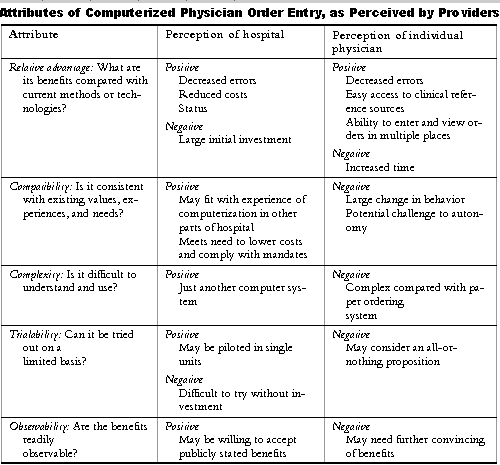Even though clinical information technology systems may have the potential to reduce medical errors, very few studies have evaluated these emerging technologies. A notable exception is the computerized physician order entry (CPOE) system, which in a number of studies has been found to reduce medication errors. State governments, employers, and organizations interested in health care quality and improvement have called for CPOE implementation in health care facilities, but very few currently use the technology. In Computerized Physician Order Entry Systems in Hospitals: Mandates and Incentives, authors David F. Doolan, M.B.B.S., M.B.A., and David W. Bates, M.D., M.Sc., discuss CPOE design, examine barriers to its dissemination, and present strategies for promoting further adoption. Doolan and Bates conclude that government, employers, and insurers should share the costs of CPOE and fund further research into its benefits and means of implementation.
CPOE is the direct entry into a computer of orders for diagnostic tests, medications, patient care, and referrals by physicians or other authorized prescribers. CPOE decreases the amount of transcription, increases order accuracy and completeness, enables access from multiple locations, and provides important decision support at the point of care. Clinical decision support, in particular, can lead to fewer medical errors and more clinically appropriate and cost-effective ordering of medications and tests. CPOE decision support includes: drug dose, allergy, and interaction checking; duplicate order notification; recommendations for pre- or post-administration tests; access to clinical reference information and guidelines; and substitute medication and test recommendations. Studies of CPOE in major hospitals have found that the technology significantly reduced adverse drug events and errors, generated lower costs, increased use of preventive care interventions, and improved clinical care.
Despite these potential benefits, very few institutions have adopted CPOE technology. In a 1998 survey of 633 hospitals, only 17 percent had CPOE systems. Even in those hospitals that had the technology, the majority reported that less than 10 percent of orders were computerized and less than 10 percent of medical staff used the system. Only seven hospitals (1%) had more than 90 percent of orders computerized and physician usage rates higher than 90 percent.
The authors provide examples of four hospitals where CPOE technology serves a range of functions. In inpatient units, for example, physicians used computers to order tests, medications, patient care, and referrals; to access patient results; and to make electronic notes. CPOE implementation was achieved in these hospitals through high-level leadership, long-term commitment of resources, extensive training and support, and involvement of physicians and other providers.
Many of the barriers to CPOE adoption identified more than 20 years ago--lack of clinician involvement, inadequate long-term financial commitment, poor planning and implementation, substandard functionality and reliability, and the absence of standardized medical terminology--still exist today. The transition to CPOE systems profoundly affects work practices and requires a major commitment of effort and resources. For example, physicians report that while the ability to place orders from any location is convenient, it still takes longer to order through CPOE technology. Another barrier is that many hospitals rely on outmoded or incompatible technologies; such systems will need to be improved and integrated in order to be effective. Current commercial CPOE systems also fall short, though better systems may soon be available. Most important, there are few financial incentives for organizations to adopt the technology: reducing the length of hospital stays by avoiding adverse drug events or reducing the number of tests needed, for example, would not result in cost savings for physicians or hospitals in the current fee-for-service environment.
The authors employ "diffusion of innovation theory" to shed light on the rate of CPOE adoption. This theory holds that the adoption of a new technology is hastened by: advantages relative to existing methods, consistency or compatibility with existing needs, ability to try out the technology on a limited basis, and observable benefits. Increased complexity generally leads to slower rates of adoption. CPOE adoption involves two steps, with a hospital first deciding to adopt the system and then individual physicians deciding to use it. In this decision-making process, it is the perception of a technology's attributes, rather than actual attributes, that matters. (See table.)
The authors conclude that a comprehensive approach to promoting further adoption of CPOE is necessary. Financial incentives such as state or federal grants for technology implementation, differential reimbursement schemes to reward hospitals for using CPOE, and collective contracting with providers could encourage adoption and use. Research that makes the benefits of CPOE more apparent might improve physicians' perceptions of the technology. Strategies to minimize the time burdens of using CPOE might include: ensuring fast system response time; allowing physicians to enter all orders at once; providing predetermined lists for common conditions; and integrating ordering systems with patient results and notes.
Further research into CPOE adoption and usage is required. In the public sector, the Agency for Healthcare Research and Quality could oversee the evaluation of CPOE's implementation and impact, while the American Medical Informatics Association could coordinate the development of guidelines, standards, and measurement criteria in conjunction with professional organizations and commercial vendors.
CPOE holds the potential to bring real-time, evidence-based decision support to physicians. Without a coordinated plan to encourage CPOE adoption and evaluate its impact, however, its diffusion will continue to be slow.
